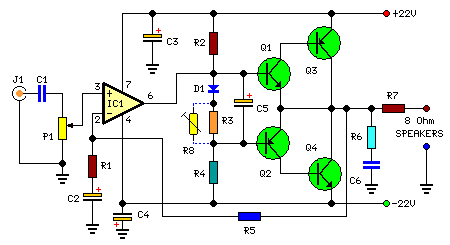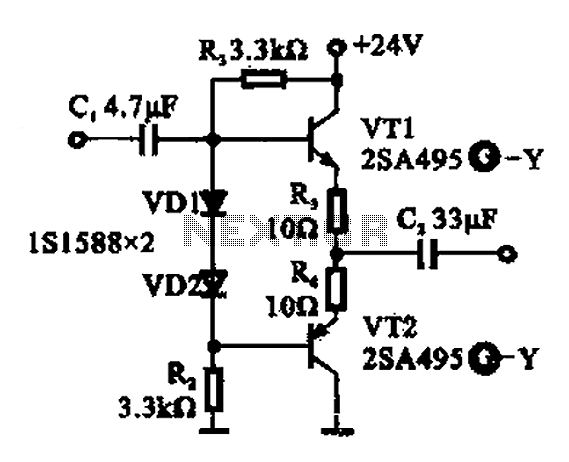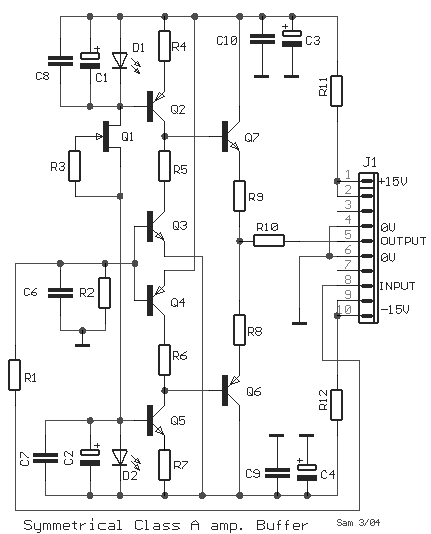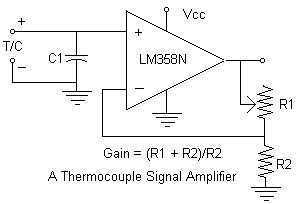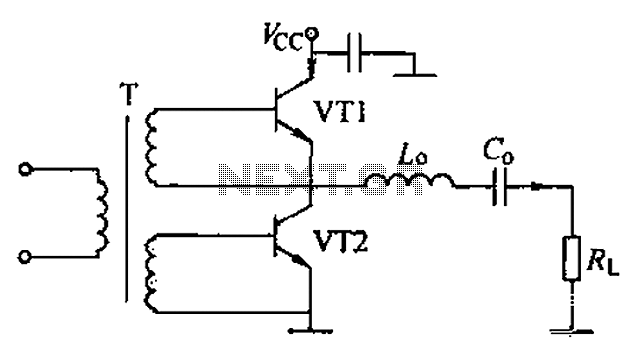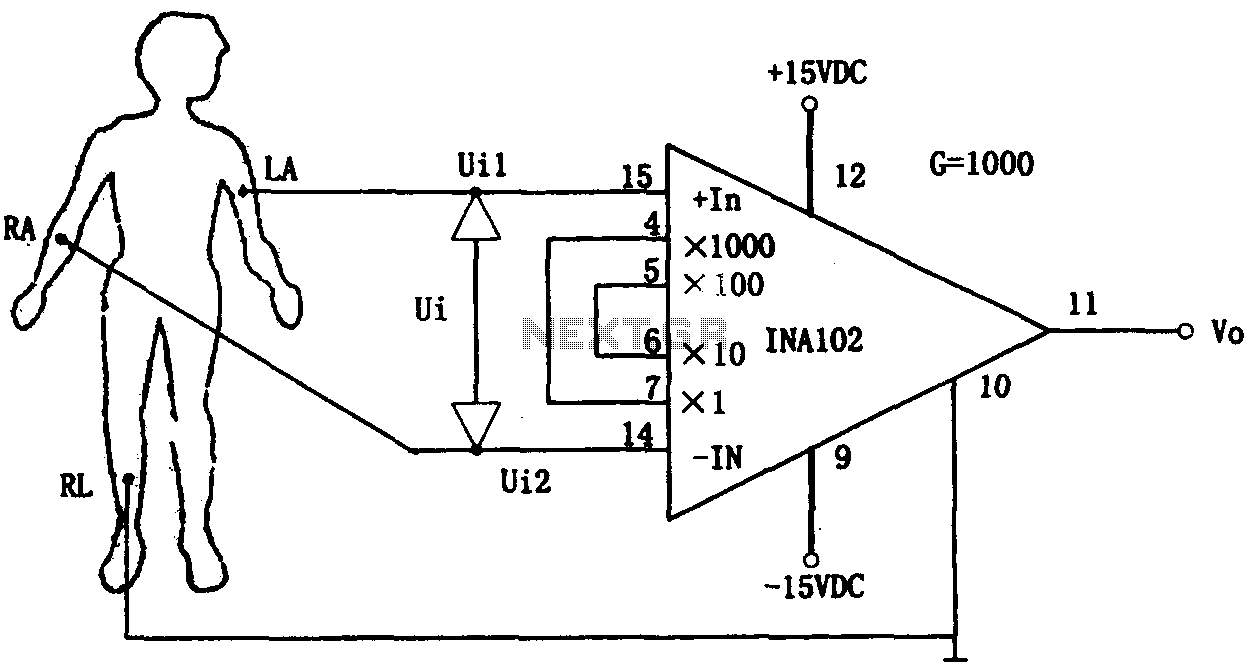
40 MHz Wideband RF Amplifier
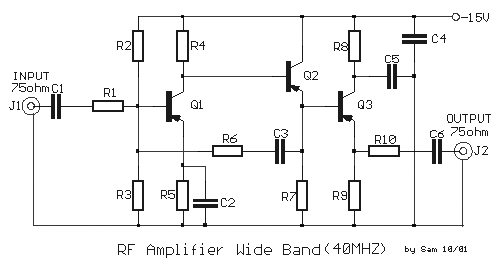
A wideband transmission or communication channel consists of a broader bandwidth than a single voice channel, utilizing a carrier wave of a specific modulated frequency. This allows for the transmission of more information than narrowband systems, but less than broadband systems. The AF125 is a high-frequency germanium PNP transistor that operates at 75 MHz, with a voltage rating of 20 V and a current of 10 mA, housed in a TO-72 package. It is utilized in RF and IF amplifiers, preamplifier mixers, FM mixers, and oscillators up to 900 MHz. The circuit's input is connected via a BNC jack, enabling sensitivity adjustments to enhance performance in the presence of interference from the RF amplifier's aerial source. The resonant circuit within the amplifier is optimized for mid-wave and low-wave frequencies, oscillating up to 40 MHz. The circuit draws a total current of 7 mA and provides a gain of 20 dB, powered by a DC supply ranging from 12 V to 15 V. The input and output are designed to be compatible with coaxial cables that have a characteristic impedance of 75 Ohms. Short coaxial cables are typically used in ham radio setups, home video equipment, and measurement electronics, while longer cables are employed for connections in television, radio networks, and telephone companies. Common issues associated with coaxial cables include ground loops, common current, radiation induction, signal leakage, and transformer effects. The design of wideband RF amplifiers is integral to RF measuring equipment, communication receivers such as GPS devices, and other related applications. These amplifiers are intended to function alongside waveform generators, catering to wideband, high-voltage applications.
A comprehensive understanding of the wideband RF amplifier circuit reveals its essential role in modern communication systems. The AF125 transistor serves as the cornerstone of this circuit, providing the necessary amplification for high-frequency signals. Its characteristics enable effective operation within the specified frequency range, making it suitable for various applications including FM mixing and signal processing.
The BNC jack input facilitates easy connectivity, allowing for quick adjustments to receiver sensitivity. This feature is particularly beneficial in environments with significant interference, where optimizing the circuit's performance can enhance signal clarity and reliability. The resonant circuit’s design is crucial for maintaining stability and efficiency at mid and low wave frequencies, ensuring that the amplifier can handle a range of signal types without distortion.
The specified current consumption of 7 mA is indicative of the circuit's efficiency, especially considering the gain of 20 dB achieved under these conditions. The operation within a 12 V to 15 V DC supply range allows for flexibility in power sourcing, accommodating various electronic setups.
Compatibility with 75 Ohm coaxial cables is a critical design aspect, as it ensures minimal signal degradation and optimal transmission quality. The choice of cable length—short for local applications and long for broader connections—highlights the versatility of the circuit in different operational contexts.
The potential issues associated with coaxial cables, such as ground loops and signal leakage, must be considered during implementation. Proper grounding and shielding techniques can mitigate these problems, enhancing overall circuit performance.
In summary, the design and functionality of wideband RF amplifiers like the one utilizing the AF125 transistor are fundamental to the advancement of communication technologies, enabling robust and high-fidelity signal transmission across a variety of applications.Wideband a transmission or communication channel or medium which consists of a wider bandwidth than one voice channel with a carrier wave of a certain modulated frequency and is capable of transmitting more information than narrowband but less than broadband AF125 a high frequency germanium PNP transistor operating at 75 MHz, with voltageof 20 V at 10 mA current, enclosed in a TO-72 package, and used for RF & IF amplifier, preamplifier mixer, FM mixer, and oscillator up to 900 MHz The input of the circuit comes from the BNC jack where the sensitivity of the receiver can be adjusted to increase accordingly. This can be achieved in the presence of interference between the circuit and the aerial source of the RF amplifier.
The resonant circuit used in the amplifier circuit is made to be suitable for mid waves and for the low waves which oscillates up to 40 MHz. The circuit is consuming a total of 7 mA of current while the gain is in the measurement of 20 dB. All these values are due to the presence of a 12 V up to 15 V DC supply. The input and the output of the circuit are designed to be compatible with coaxial cables with complex resistance of 75 Ohms.
Short coaxial cables are being used for ham radio setups, home video equipment, and in measurement electronics while long coaxial cables are used for connecting television, radio networks or telephone companies. There are some problems that have been encountered in using coaxial cables such as ground loops, common current and radiation, induction, signal leakage, and transformer effect.
The idea behind the construction of wideband RF amplifiers may be found in RF measuring equipment, communication receivers like GPS receivers, and other related devices. They are designed to operate in conjunction with its series of waveform generators that will provide a solution for wideband, high-voltage applications.
🔗 External reference
A comprehensive understanding of the wideband RF amplifier circuit reveals its essential role in modern communication systems. The AF125 transistor serves as the cornerstone of this circuit, providing the necessary amplification for high-frequency signals. Its characteristics enable effective operation within the specified frequency range, making it suitable for various applications including FM mixing and signal processing.
The BNC jack input facilitates easy connectivity, allowing for quick adjustments to receiver sensitivity. This feature is particularly beneficial in environments with significant interference, where optimizing the circuit's performance can enhance signal clarity and reliability. The resonant circuit’s design is crucial for maintaining stability and efficiency at mid and low wave frequencies, ensuring that the amplifier can handle a range of signal types without distortion.
The specified current consumption of 7 mA is indicative of the circuit's efficiency, especially considering the gain of 20 dB achieved under these conditions. The operation within a 12 V to 15 V DC supply range allows for flexibility in power sourcing, accommodating various electronic setups.
Compatibility with 75 Ohm coaxial cables is a critical design aspect, as it ensures minimal signal degradation and optimal transmission quality. The choice of cable length—short for local applications and long for broader connections—highlights the versatility of the circuit in different operational contexts.
The potential issues associated with coaxial cables, such as ground loops and signal leakage, must be considered during implementation. Proper grounding and shielding techniques can mitigate these problems, enhancing overall circuit performance.
In summary, the design and functionality of wideband RF amplifiers like the one utilizing the AF125 transistor are fundamental to the advancement of communication technologies, enabling robust and high-fidelity signal transmission across a variety of applications.Wideband a transmission or communication channel or medium which consists of a wider bandwidth than one voice channel with a carrier wave of a certain modulated frequency and is capable of transmitting more information than narrowband but less than broadband AF125 a high frequency germanium PNP transistor operating at 75 MHz, with voltageof 20 V at 10 mA current, enclosed in a TO-72 package, and used for RF & IF amplifier, preamplifier mixer, FM mixer, and oscillator up to 900 MHz The input of the circuit comes from the BNC jack where the sensitivity of the receiver can be adjusted to increase accordingly. This can be achieved in the presence of interference between the circuit and the aerial source of the RF amplifier.
The resonant circuit used in the amplifier circuit is made to be suitable for mid waves and for the low waves which oscillates up to 40 MHz. The circuit is consuming a total of 7 mA of current while the gain is in the measurement of 20 dB. All these values are due to the presence of a 12 V up to 15 V DC supply. The input and the output of the circuit are designed to be compatible with coaxial cables with complex resistance of 75 Ohms.
Short coaxial cables are being used for ham radio setups, home video equipment, and in measurement electronics while long coaxial cables are used for connecting television, radio networks or telephone companies. There are some problems that have been encountered in using coaxial cables such as ground loops, common current and radiation, induction, signal leakage, and transformer effect.
The idea behind the construction of wideband RF amplifiers may be found in RF measuring equipment, communication receivers like GPS receivers, and other related devices. They are designed to operate in conjunction with its series of waveform generators that will provide a solution for wideband, high-voltage applications.
🔗 External reference
